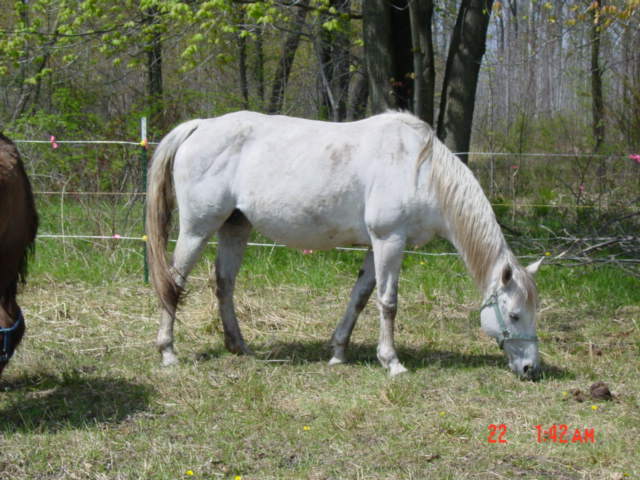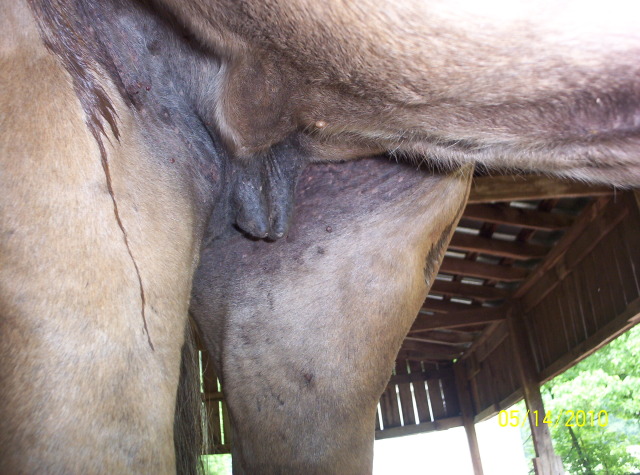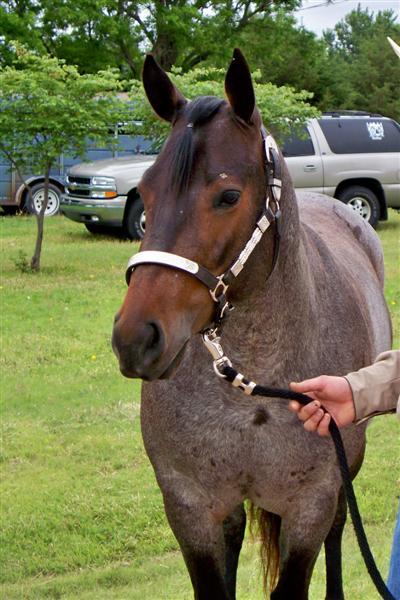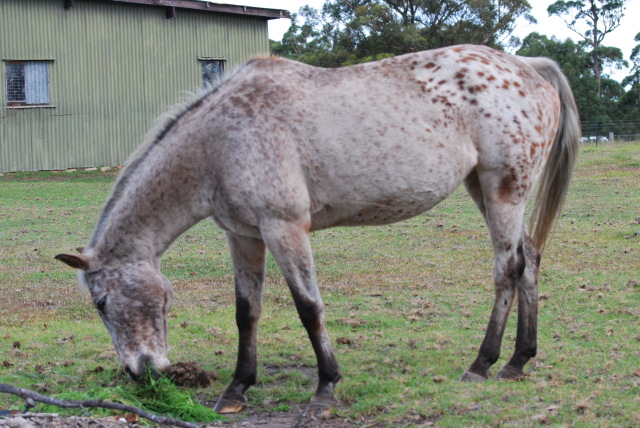QuestionQUESTION: I have a 20 year old NFQH mare who was live cover pasture breeding for 2 weeks. She is 359 days from the day we picked her up. 6 weeks after picking her up we had her palpated by a vet who said she was pregnant at about 6-7 weeks. Her bag is starting to hang down, but not filling up. If you touch her teats she does have a white tinged watery liquid, but nothing else. Is there anything I should do or when should I worry.
Thanks, Colleen
ANSWER: Hi Colleen,
Some mares' udders will not fill until just prior to delivery, during delivery, or sometimes directly after the foal is born.
A white tinge to the fluid coming from her teats should indicate that she is quite close to foaling. I have seen some mares have whitish fluid for a week prior to foaling, but generally, it is within days.
If she has been eating fescue grass during her pregnancy, that can have an affect on her producing milk, can prolong the pregnancy and can make the sack that the baby is in very thick. If you know that she has been eating fescue, it is very important that you be there for the delivery, as you may have to tear the sack open for the foal when it is born.
Here is one thing you can do... you can test the fluid coming from her udder with total hardness test strips. They are used to test water for hardness. The kind I use are SofChek and they can be obtained from anywhere that installs water softeners. You want to mix the fluid from the udder with 6 parts of distilled water. (It MUST be distilled water) So, if you got 1 tsp. of fluid, mix it with 6 tsp. of distilled water. Dip the test strip in, shake the strip off of excess fluid and instantly compare it to the colors on the bottle. If the color on the strip compares to the very last color on the bottle, which would be 425ppm, then most mares will foal within 24 hours of that time. I use them all the time and they help you to know when it is time to start watching your mare.
If you're overly concerned about your mare, then by all means, have the vet come out and palp her. I had a mare who was at 362 days and had the vet come check her. He told me that he could feel the foal, that it was in the birth canal and she should foal within 2 or 3 days. She did indeed foal on day 365. I do know how worrisome and frustrating it is when they go that long. If your mare is acting as though she is in pain, is not eating normally, or just generally acts "off", then I'd call the vet.
Hang in there, just remember, that baby has to come out some time :)
---------- FOLLOW-UP ----------
QUESTION: Okay, we are now 369 days into it. I thought she was getting close last weekend her bag was filling up and all, then on Wednesday it looked like she had no bag at all, then again on Thursday the bag is filling up again. She looks big and miserable. She has not been in any contact with fescue grass. I am so careful about the low endophyte grasses.
AnswerHi Colleen,
Is the fluid coming out still whitish? Have you seen or felt the foal moving at all?
Here are a few things I found in an article on Horse.com
There are pathological conditions that do result in prolonged gestation. The two most common are fescue toxicosis and degeneration of the uterine lining. The first condition can occur in any mare on pasture that contains fescue grass infected with an endophyte.
The endophyte seems to affect the neuroendocrine system responsible for timing of delivery. Most fescue grasses contain the endophyte because it grows better in drought conditions when infected. Other symptoms that pregnant mares might have if pastured on endophyte-infected fescue pasture is minimal udder development, minimal or no milk production, premature separation of the placenta, an oversized foal, and/or the delivery of a large, weak foal. These problems can be eliminated by management techniques or treatment.
The second condition, uterine degeneration, usually occurs in older mares (greater than 12 years old) which have had several foals. It also can occur in older mares which were not bred for the first time until their mid- to late teens because they had an extensive show or racing career.
The mare is very different from other animals in that the placenta does not attach until late in the pregnancy, around 60 to 100 days. The pregnancy is maintained by the secretions of the uterine glands. Once the placenta attaches to the mare's uterus, the uterine glands begin a second role--ensuring that the microcotyledon (the placental/maternal attachment) receives nourishment.
If there is degeneration of the uterine glands, then the glands do not produce the correct quantity of "uterine milk" and the pregnancy suffers. The foal grows more slowly in utero, and therefore it takes more time for it to develop.
There is an old, wise saying about delivery: The foal picks the day it is to be born, and the mare picks the time. This is really true. If the foal is not completely developed, the pregnancy continues until the foal has finished developing.
RED ALERTS DURING PREGNANCY AND DELIVERY
By Dr. Wendy Vaala
ABNORMAL EVENT: Prolonged gestation length (>360days)
CAUSES: Fescue toxicosis, pituitary tumor in older mares, hypothyroid, wrong due date
ACTIONS TO TAKE: Check breeding dates. Call vet. Rectal palpation, ultrasound exam, measure hormone levels
ABNORMAL EVENT: No udder development, agalactia
CAUSES: Wrong due date, fescue toxicosis, endocrine abnormality (abnormal estrogen:progestagen ratio, hypothyroid), poor nutrition
So, needless to say, at this point, considering your mare is 370 days and is 20 years old, my personal opinion is that it is time to call the vet. For peace of mind if nothing else.
Please keep me posted on the outcome. I'm wishing you and your mare the best.

 Dark Bay vs. Fading Black
Question
Ace of Spades
Since you specialize in breeding
Dark Bay vs. Fading Black
Question
Ace of Spades
Since you specialize in breeding
 13yr old QH 367 days with foal
Question
Blue in pasture
Hello,
Im new to the foal bi
13yr old QH 367 days with foal
Question
Blue in pasture
Hello,
Im new to the foal bi
 Is my mare pregnant, you think?
QuestionSunshine
QUESTION: Hello Sandy.
I bough
Is my mare pregnant, you think?
QuestionSunshine
QUESTION: Hello Sandy.
I bough
 Performance mare breeding
Question
5 yr old mare
Currently have a 5 year old quar
Performance mare breeding
Question
5 yr old mare
Currently have a 5 year old quar
 breeding old mare
Question
Star
Im just wondering how old is too old to b
breeding old mare
Question
Star
Im just wondering how old is too old to b